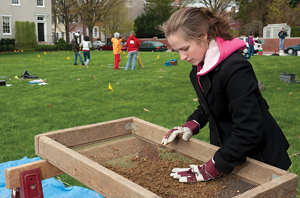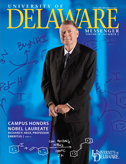Students help unearth New Castle's past

ON THE GREEN | A group of anthropology and material culture studies students really got their hands dirty last spring.
Their archaeological fieldwork on the 22-room mansion, which was built by the son of Delaware’s George Read, a signer of the Declaration of Independence and the Constitution, is part of a larger, two-decade-long project to piece together the past of Delaware’s Colonial capital.
Led by anthropology Prof. Lu Ann De Cunzo, the multi-year study, in partnership with the Delaware Historical Society, aims to preserve and interpret archaeological remains on the museum grounds. While it has trained nearly 70 high school and college students since its inception in 1994, last spring was the first time De Cunzo included a semester-long classroom component in which undergraduates attended class on the Read House site and performed excavations of the property.
“New Castle remains the least-studied North Atlantic coastal Colonial capital,” she says, “and the town’s unique, nonrenewable, fragile archaeological remains offer a spectacular opportunity to explore the past in the present.”
Beginning in March, the students spent each Friday in the field, mapping, excavating and conducting soil and artifact samples. “This isn’t a discipline you can just learn from a book,” says anthropology major Elanor Sonderman.
In addition to the archaeological fieldwork, the students conducted historical research on the property and on previous owners of the land.
As an anthropology and women’s studies double major, Marissa Kinsey says she was fascinated to discover a will that left specific instructions for the living arrangements of the deceased’s wife and slave.
“Objects alone aren’t enough,” she says. “Part of the satisfaction of discovering artifacts is learning more about the people who used them.”





